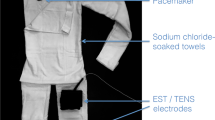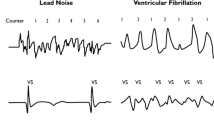Summary
Pacing threshold is not a stable value during the pacemaker‘s life. It is affected by many physiological, pharmacological and pathophysiological factors. A pacing system able to confirm capture and automatically adjust its output to the actual pacing threshold is highly desirable for a prolonged battery life and maximal patient safety. The AutocaptureTM of St. Jude Medical and the Capture ManagementTM of Medtronic are currently available on the market. The key feature is the measurement of the evoked response (ER) signal by the pacemaker for capture confirmation. In case of loss of capture, the AutocaptureTM System delivers a back up safety pulse of 4.5 Volt and 0.49 ms and starts a new threshold search. The pacemaker adapts its output to 0.3V/0.25V above the newly measured threshold. This system needs bipolar leads with low polarization for the first generation in Microny® and Regency® pacemakers; in the second generation with Affinity® and Integrity® pacemakers various bipolar leads are suitable. The Capture ManagementTM System of Medtronic, available in the Kappa® DR 700 series, performs a two point automatic threshold search once every day during rest. The output is determined by the programmed safety margin (nominal 1.5×voltage threshold). A backup pulse is only delivered during the threshold search. No special electrodes are necessary. These functions were shown to work safely and efficaciously in multicenter trials to decrease the current consumption with a prolongation of battery life up to 142%. The patients safety was increased by identifying changes of the capture threshold over time and adjusting the pacing stimulus. The conventional safety margins of 100% might not be safe for all patients. We also learned much about lead maturation and lead instability by the possibility of continuous follow-up of threshold changes in a larger group of leads in order to identify the risk group of about 10% of patients with late threshold increase and lead instability.
Zusammenfassung
Die Stimulationsreizschwelle ist einer Vielzahl von physiologischen, pharmakologischen und pathologischen Einflüssen ausgesetzt und verändert sich nach der Implantation und im chronischen Verlauf. Ein System zur automatischen Reizschwellenmessung kann daher durch Anpassung der Stimulationsenergie an die tatsächlichen Bedürfnisse sowohl die Batterielebensdauer verlängern als auch die Sicherheit für die Patienten erhöhen. Derzeit stehen folgende Systeme zur Auswahl: AutocaptureTM von St. Jude Medical und Capture-ManagementTM von Medtronic. Das Herzstück jedes Systems zur automatischen Reizschwellenmessung ist die sichere Detektion der evozierten Reizantwort (ER) zur Bestätigung einer effektiven Myokarddepolarisation. Bei ineffektiver Stimulation gibt das AutocaptureTM System einen Sicherheitsimpuls von 4,5V/0,49 ms ab und startet eine neue Reizschwellensuche. Die Stimulationsamplitude liegt dann immer 0,3 bzw. 0,25 V über der zuletzt gemessenen Reizschwelle. Das System braucht bipolare Sonden mit niedriger Polarisation für die erste Generation in Microny®- und Regency®-Schrittmachern, die zweite Generation AutocaptureTM in Affinity®- und Integrity®-Schrittmachern kann mit fast allen bipolaren Sonden kombiniert werden. Das Capture-ManagementTM System von Medtronic in den Kappa®-SR- und -DR-Schrittmachern der 700 Serie erstellt eine Chronaxie-Reobasen Reizschwellenkurve aus zwei automatisch gemessenen Punkten einmal täglich in Ruhe. Die Stimulationsamplitude richtet sich dann nach der programmierten Sicherheitsmarge (nominal 1,5×Spannungsreizschwelle), ein Sicherheitsimpuls wird nur während der Reizschwellenmessung abgegeben. Dieses System kann auch mit unipolaren Sonden kombiniert werden. Die sichere und regelrechte Funktion beider Systeme konnte in Multicenter-Studien nachgewiesen werden, eine potentielle Verlängerung der Schrittmacherfunktionsdauer wurde mit bis zu 142% berechnet. Auch steigt die Sicherheit für den Patienten durch die automatische Anpassung der Stimulationsamplitude an Reizschwellenerhöhungen und die Abgabe eines Sicherheitsimpulses. Die konventionelle Programmierung eines 100%igen Sicherheitsbereiches über der Reizschwelle kann für einige Patienten zu gering sein. Durch die Speicherung der Reizschwellenmessungen beider Systeme konnten viele neue Erkenntnisse über die Einheilphase und die Sondenstabilität an einer größeren Anzahl von Sonden gewonnen werden. Dies erleichtert die Identifizierung der ca. 10% Patienten mit dem Risiko einer Sondeninstabilität oder eines späten Reizschwellenanstiegs.
Similar content being viewed by others
Author information
Authors and Affiliations
Additional information
Eingegangen: 23. Juli 2001 Akzeptiert: 17. August 2001
Rights and permissions
About this article
Cite this article
Anelli-Monti, M., Mächler, H., Oberwalder, P. et al. AutocaptureTM- und Capture-ManagementTM Aktuelle Konzepte zur automatischen Reizschwellenmessung und Anpassung der Stimulationsamplitude. Herzschr Elektrophys 12, 186–194 (2001). https://doi.org/10.1007/s003990170003
Published:
Issue Date:
DOI: https://doi.org/10.1007/s003990170003




